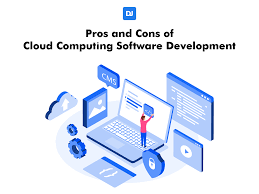Cloud Software Development: Unlocking the Power of the Cloud
In today’s fast-paced digital landscape, businesses are constantly seeking innovative ways to streamline their operations and enhance their productivity. Cloud software development has emerged as a game-changer, offering unprecedented opportunities for organizations to harness the power of the cloud.
So, what exactly is cloud software development? In simple terms, it refers to the process of creating and deploying software applications that run on cloud infrastructure. Instead of relying on traditional on-premises servers, cloud software leverages remote servers hosted by third-party providers. This approach offers numerous benefits that have revolutionized the way we build and deploy applications.
One of the key advantages of cloud software development is scalability. With traditional software development, scaling up or down often requires significant investment in hardware and infrastructure. However, with cloud-based solutions, developers can easily adjust resources based on demand. Whether you need to handle a sudden surge in traffic or scale down during quieter periods, the cloud provides flexibility without compromising performance.
Another major advantage is cost-effectiveness. Traditional software development often requires substantial upfront investments in hardware and licenses. On the other hand, cloud-based solutions operate on a pay-as-you-go model, allowing businesses to only pay for the resources they actually use. This eliminates unnecessary expenses and enables organizations to allocate their budgets more efficiently.
Cloud software development also offers enhanced collaboration capabilities. Development teams can work seamlessly across different locations and time zones, accessing shared resources and collaborating in real-time. This fosters greater efficiency and productivity by eliminating geographical barriers and allowing for continuous collaboration throughout the development process.
Furthermore, security is a top priority for any organization handling sensitive data or customer information. Cloud service providers invest heavily in robust security measures to protect data from breaches and unauthorized access. By leveraging these secure infrastructures, businesses can ensure that their applications are built on a foundation of strong security protocols.
Additionally, cloud software development enables faster time-to-market for applications. With traditional development, setting up and configuring servers can be time-consuming and prone to delays. Cloud-based solutions provide developers with pre-configured environments, reducing setup time and allowing for faster deployment. This agility is crucial in today’s competitive landscape where speed can make all the difference.
In conclusion, cloud software development has transformed the way we build and deploy applications. Its scalability, cost-effectiveness, collaboration capabilities, enhanced security, and faster time-to-market make it an attractive choice for businesses of all sizes. By harnessing the power of the cloud, organizations can unlock new levels of efficiency and innovation in their software development processes. Embracing cloud software development is not just a trend but a strategic move that empowers businesses to stay ahead in the digital era.
Frequently Asked Questions: Cloud Software Development Demystified
- What are the benefits of cloud software development?
- How can I get started with cloud software development?
- What tools and technologies are used in cloud software development?
- How secure is cloud software development?
- What are the best practices for developing cloud applications?
- How do I troubleshoot common issues in cloud software development?
What are the benefits of cloud software development?
Cloud software development offers several benefits that have revolutionized the way applications are built and deployed. Here are some key advantages:
- Scalability: Cloud-based solutions allow for easy scalability, enabling businesses to adjust resources based on demand. Whether you need to handle sudden spikes in traffic or scale down during quieter periods, the cloud provides flexibility without compromising performance.
- Cost-effectiveness: Traditional software development often requires significant upfront investments in hardware and licenses. In contrast, cloud-based solutions operate on a pay-as-you-go model, allowing businesses to only pay for the resources they actually use. This eliminates unnecessary expenses and allows for more efficient budget allocation.
- Collaboration: Cloud software development enables seamless collaboration among development teams across different locations and time zones. Shared resources and real-time collaboration tools foster greater efficiency and productivity by eliminating geographical barriers and facilitating continuous collaboration throughout the development process.
- Enhanced Security: Cloud service providers invest heavily in robust security measures to protect data from breaches and unauthorized access. By leveraging these secure infrastructures, businesses can ensure that their applications are built on a foundation of strong security protocols.
- Faster Time-to-Market: Setting up and configuring servers can be time-consuming with traditional development methods. Cloud-based solutions provide developers with pre-configured environments, reducing setup time and allowing for faster deployment. This agility is crucial in today’s competitive landscape where speed can make all the difference.
- Reliability: Cloud service providers typically offer high levels of reliability through redundant systems and backup mechanisms. This ensures that applications built on the cloud have minimal downtime, providing users with a consistent experience.
- Accessibility: With cloud software development, applications can be accessed from anywhere with an internet connection, enabling remote work capabilities and enhancing user accessibility across different devices.
- Innovation Opportunities: The cloud provides access to a wide range of tools, frameworks, and APIs that can accelerate application development processes and enable innovative features such as machine learning, artificial intelligence, and big data analytics.
In summary, cloud software development offers scalability, cost-effectiveness, collaboration capabilities, enhanced security, faster time-to-market, reliability, accessibility, and innovation opportunities. These benefits make it an attractive choice for businesses seeking to optimize their software development processes and stay competitive in the digital era.
How can I get started with cloud software development?
Getting started with cloud software development can seem overwhelming, but with the right approach, you can navigate the process smoothly. Here are some steps to help you get started:
- Understand the Cloud: Familiarize yourself with the concept of cloud computing and its different models (such as Infrastructure as a Service, Platform as a Service, and Software as a Service). Learn about key cloud service providers like Amazon Web Services (AWS), Microsoft Azure, and Google Cloud Platform.
- Define Your Goals: Determine what you want to achieve with cloud software development. Are you looking to build a new application from scratch or migrate an existing one to the cloud? Clearly define your goals and objectives to guide your development process.
- Choose the Right Cloud Provider: Research different cloud service providers and select one that aligns with your requirements in terms of pricing, scalability, security, support, and available services. Consider factors like server locations, compliance certifications, and integration options.
- Learn Cloud Technologies: Gain knowledge of the specific technologies used in cloud software development. This may include understanding containerization platforms like Docker or orchestration tools like Kubernetes. Familiarize yourself with programming languages commonly used in cloud development such as Python, Java, or JavaScript.
- Explore Cloud Services: Start exploring various cloud services offered by your chosen provider that can support your application development needs. These may include databases (relational or NoSQL), storage services, messaging systems, authentication services, serverless computing platforms, and more.
- Set Up Development Environment: Set up a local development environment on your machine using tools provided by your chosen cloud provider or third-party tools that integrate well with their services. This will allow you to develop and test applications locally before deploying them to the cloud.
- Follow Best Practices: Embrace best practices for secure coding in the cloud environment. Implement proper access controls, encryption mechanisms for data at rest and in transit, backup and disaster recovery strategies, and regular monitoring of your cloud resources.
- Start Small: Begin with a small project or a proof of concept to familiarize yourself with cloud development. This will allow you to gain hands-on experience and gradually scale up as you become more comfortable with the cloud environment.
- Leverage Documentation and Tutorials: Cloud service providers offer extensive documentation, tutorials, and online resources to help you get started. Utilize these materials to understand the services, best practices, and recommended architectures for building applications in the cloud.
- Join Communities: Engage with developer communities, forums, and online groups focused on cloud software development. Participate in discussions, ask questions, and learn from experienced professionals who can provide guidance and insights based on their own experiences.
Remember that cloud software development is an ongoing learning process. Stay up-to-date with the latest trends, attend webinars or conferences, and continuously expand your knowledge to make the most out of this transformative technology.
What tools and technologies are used in cloud software development?
Cloud software development relies on a range of tools and technologies to build, deploy, and manage applications in the cloud. Here are some commonly used ones:
- Cloud Service Providers: Major cloud service providers like Amazon Web Services (AWS), Microsoft Azure, and Google Cloud Platform (GCP) offer a wide range of services and tools specifically designed for cloud software development.
- Infrastructure as Code (IaC): Tools like Terraform and AWS CloudFormation enable developers to define and provision cloud infrastructure resources programmatically. These tools allow for efficient management of infrastructure components such as virtual machines, storage, networking, and more.
- Containers: Containerization technologies like Docker provide a lightweight and portable way to package applications along with their dependencies. Containers enable consistent deployment across different environments, making it easier to develop and deploy applications in the cloud.
- Orchestration: Tools like Kubernetes help manage containerized applications at scale. They automate deployment, scaling, and management of containers across clusters of servers, ensuring high availability and efficient resource utilization.
- Serverless Computing: Serverless platforms such as AWS Lambda or Azure Functions allow developers to focus solely on writing code without worrying about server management. These platforms automatically scale the application based on demand, reducing operational overheads.
- Continuous Integration/Continuous Deployment (CI/CD): CI/CD tools like Jenkins or GitLab CI facilitate automated building, testing, and deployment of cloud software applications. They enable seamless integration with version control systems and streamline the release process.
- Monitoring and Logging: Tools such as Prometheus, Grafana, or AWS CloudWatch provide monitoring capabilities for tracking application performance metrics, resource utilization, and log aggregation in real-time.
- API Gateways: API gateways like AWS API Gateway or Azure API Management help expose APIs securely to external developers or services while providing features like authentication, rate limiting, caching, etc.
- DevOps Collaboration Tools: Collaboration platforms like Slack or Microsoft Teams enhance communication and collaboration among development, operations, and other teams involved in cloud software development.
- Security Tools: Cloud security services like AWS Identity and Access Management (IAM) or Azure Active Directory (AD) enable fine-grained access control to cloud resources, ensuring secure authentication and authorization.
It’s important to note that the choice of tools and technologies may vary depending on the specific requirements and preferences of each development team or project.
How secure is cloud software development?
Cloud software development can be highly secure when implemented and managed properly. Cloud service providers invest significant resources in ensuring the security of their infrastructure, often employing advanced security measures and protocols to protect customer data. Here are some key aspects that contribute to the security of cloud software development:
- Data Encryption: Cloud service providers typically employ encryption techniques to protect data both in transit and at rest. This ensures that sensitive information remains secure even if it is intercepted or accessed by unauthorized parties.
- Access Control: Cloud platforms offer robust access control mechanisms, allowing organizations to define granular permissions and restrict access to their applications and data. Multi-factor authentication (MFA) is often available as an additional layer of security for user authentication.
- Physical Security: Cloud service providers maintain highly secure data centers with stringent physical security measures, such as video surveillance, biometric access controls, and 24/7 monitoring. These facilities are designed to protect against physical threats and unauthorized access.
- Regular Audits and Compliance: Cloud providers undergo regular third-party audits to ensure compliance with industry standards and regulations (e.g., ISO 27001, SOC 2). These audits assess the provider’s adherence to strict security practices, giving customers confidence in the security of their cloud infrastructure.
- Redundancy and Disaster Recovery: Cloud platforms often have built-in redundancy mechanisms that replicate data across multiple servers or regions. This helps ensure business continuity in case of hardware failures or natural disasters.
- Security Updates and Patching: Cloud service providers actively monitor their systems for vulnerabilities and release regular updates and patches to address any potential security risks promptly.
- DDoS Mitigation: Distributed Denial-of-Service (DDoS) attacks can disrupt services by overwhelming servers with a flood of traffic. Cloud platforms typically have robust DDoS mitigation strategies in place to detect and mitigate these attacks effectively.
However, it’s important to note that while cloud service providers offer a secure foundation, the security of cloud software development also relies on the practices and configurations implemented by the organizations themselves. Implementing strong access controls, regularly updating software and applications, conducting security assessments, and educating employees about best security practices are essential for ensuring a secure cloud environment.
Ultimately, the security of cloud software development depends on a shared responsibility model between the cloud service provider and the organization using their services. By adhering to best practices and leveraging the security features provided by cloud platforms, businesses can significantly enhance the security of their cloud-based applications.
What are the best practices for developing cloud applications?
Developing cloud applications requires careful consideration and adherence to best practices to ensure optimal performance, scalability, security, and cost-effectiveness. Here are some key best practices to follow:
- Design for the cloud: When developing cloud applications, it’s important to design them specifically for the cloud environment. This involves leveraging cloud-native services, such as serverless computing or containerization, and utilizing scalable storage options like object storage or managed databases. By designing with the cloud in mind, you can take full advantage of its capabilities.
- Embrace microservices architecture: Implementing a microservices architecture allows you to break down your application into smaller, loosely coupled components that can be independently developed, deployed, and scaled. This approach promotes flexibility, scalability, and resilience in your application.
- Build for scalability: Cloud environments offer virtually unlimited scalability. To make the most of this capability, design your application to scale horizontally by adding more instances rather than vertically by increasing the resources of a single instance. Utilize auto-scaling features provided by your cloud platform to automatically adjust resources based on demand.
- Ensure high availability: Design your application with redundancy across multiple availability zones or regions provided by your cloud provider. Distributing your application across these zones ensures that if one zone fails or experiences issues, your application remains available without disruption.
- Implement robust security measures: Security should be a top priority when developing cloud applications. Follow best practices such as using strong encryption for data in transit and at rest, implementing secure access controls and authentication mechanisms, regularly updating software components to address vulnerabilities, and conducting regular security audits.
- Monitor performance and optimize resources: Continuously monitor the performance of your application in the cloud environment using monitoring tools provided by your cloud provider or third-party solutions. Analyze metrics such as response times, resource utilization, and error rates to identify bottlenecks or areas for optimization.
- Plan for disaster recovery: Develop a disaster recovery plan to ensure business continuity in the event of a failure or disaster. This includes regular backups, replication of data across multiple regions, and testing the recovery process to validate its effectiveness.
- Optimize costs: Cloud platforms offer flexibility in terms of resource allocation and usage. Optimize costs by monitoring resource utilization, utilizing auto-scaling features, leveraging reserved instances or spot instances for cost savings, and regularly reviewing your cloud service usage to eliminate unnecessary expenses.
- Implement continuous integration and deployment (CI/CD): Automate the build, testing, and deployment processes using CI/CD pipelines. This allows for faster development cycles, reduces the risk of errors during deployment, and promotes a culture of continuous improvement.
- Stay updated with cloud technology advancements: Cloud technology is constantly evolving. Stay informed about new services, features, and best practices offered by your cloud provider to ensure you are taking full advantage of the latest innovations.
By following these best practices, you can develop robust and efficient cloud applications that fully leverage the benefits of cloud computing while ensuring scalability, security, performance, and cost-effectiveness.
How do I troubleshoot common issues in cloud software development?
Troubleshooting Common Issues in Cloud Software Development
Cloud software development offers numerous benefits, but like any technology, it can come with its own set of challenges. Here are some common issues that developers may encounter during cloud software development and tips on how to troubleshoot them:
- Connectivity Problems: One of the most common issues in cloud software development is connectivity. If you’re experiencing difficulties connecting to your cloud infrastructure or services, start by checking your internet connection. Ensure that you have a stable and reliable network connection. If the issue persists, contact your cloud service provider for assistance.
- Performance Bottlenecks: Slow application performance can be frustrating for users and impact productivity. To troubleshoot performance issues, monitor your application’s resource usage and identify any bottlenecks. Check if your application is properly optimized for the cloud environment and if it’s utilizing resources efficiently. Consider scaling up or down based on demand to ensure optimal performance.
- Security Concerns: Security is a critical aspect of cloud software development. If you suspect a security breach or unauthorized access, review your security measures and protocols immediately. Ensure that you have implemented proper encryption, authentication, and access control mechanisms. Regularly update and patch your software to address any vulnerabilities.
- Integration Challenges: Integrating different systems or services can sometimes be challenging in a cloud environment. If you’re facing integration issues, carefully review the documentation provided by the service provider to ensure that you’re following the correct procedures. Check if there are any compatibility issues between different components or services and seek assistance from the provider if needed.
- Data Management: Efficient data management is crucial in cloud software development. If you’re facing data-related issues such as data loss or corruption, check if proper backup mechanisms are in place and regularly test their effectiveness. Review your data storage configurations to ensure they meet your application’s requirements.
- Cost Optimization: Cloud services operate on a pay-as-you-go model, but costs can quickly add up if resources are not managed effectively. Monitor your resource usage and identify any unnecessary or underutilized resources. Optimize your application’s architecture to make the most efficient use of cloud services and consider implementing cost management tools provided by the cloud service provider.
- Documentation and Support: If you’re encountering issues that you can’t resolve on your own, consult the documentation and support resources provided by your cloud service provider. Most providers offer extensive documentation, knowledge bases, forums, and dedicated support channels to assist developers with troubleshooting.
Remember that troubleshooting in cloud software development requires a systematic approach. Start by identifying the issue, gather relevant information, and utilize available monitoring and debugging tools. Don’t hesitate to seek assistance from your cloud service provider or consult with experienced developers in online communities or forums. With patience and persistence, you can overcome common issues and ensure smooth operation of your cloud-based applications.




